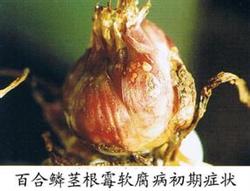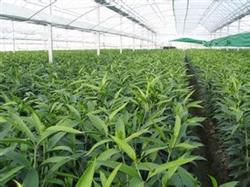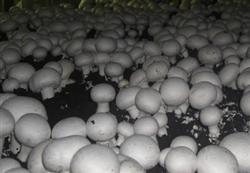Control methods of Rhizopus soft rot of lily bulb

First, the symptoms of damage: during the storage or transportation of the lily bulb, there are primary water stains on the outer skin, and then the color becomes darker, with a slightly pungent smell, the bulb becomes soft, and in serious cases, the bulb has destructive decay, and sometimes there is a thick mycelium layer on the bulb, that is, the cyst peduncle and sporangium of the pathogen. 2. Morphological characteristics of pathogens: the pathogen is Rhizopusstolonifer (Ehr.exFr.) Vuill. It is called Rhizopus creeping Rhizopus (Rhizopus nigricans), which belongs to zygotic fungi. The hyphae are colorless at first, then become dark brown, and form creeping roots. The asexual sporangium is clustered at the root node, erect and dark brown, with a spherical sporangium at the top, and many dark round spores are produced in the cyst, which are 11-14 microns in size. many bulbs are contaminated by the cyst stalks outside the root nodes of the creeping roots to produce patches of mold; the sexual state produces black zygotic spores, spherical, with protuberances on the surface. 3. The characteristics of the disease: the bacteria existed in the air or attached to the injured bulb or bulb adhering to the soil and the dead branches of the packaging material. the pathogen invaded the outer skin of the bulb from the wound, the hyphae extended to the base of the bulb, and then extended to other scales. the cyst spores of the diseased part were re-infected by airflow transmission. The suitable temperature for the disease is 15-25 ℃, and the relative humidity is 76-86%. Under the condition of poor ventilation, the bulbs can all rot in 2-4 days. Fourth, control methods: (1) when harvesting the bulb, do everything possible to reduce the wound, keep the pit temperature 8-10 ℃ and the relative humidity 70-75% during storage. (2) the bulbs of oriental lilies can be immersed in 27-29 ℃ of 50% carbendazim solution (50g of carbendazim every 4 minutes) for 15-25 minutes to control Rhizopus creeping, Penicillium, Fusarium and so on. Other varieties should be tested before use.
- Prev

A wonderful method to control lily bulb canker
(1) Choose loose fertile and well-drained loam land for soil preparation. When soil preparation, fully decomposed organic fertilizer is applied 5 square meters per mu, and deep tillage is 30~35cm. Then the bed was made according to the specification of width 110~120cm and walkway 50cm, and then 10~15kg of calcium phosphate, 4~6kg of potassium sulfate and 0.8~1.0 kg of pentachloronitrobenzene were applied to the bed surface every 100m2.
- Next

Cultivation of Agaricus bisporus with wheat straw and cow manure
Greenhouse Agaricus bisporus overwintering period generally refers to the winter solstice after the year to the next year Jingzhe this period. During this period, the hypha was in a very slow or stopped growth stage, and sometimes a few fruiting bodies were produced, but it was of little significance in production. According to the dry and wet degree of bacteria layer, two methods of dry overwintering and wet overwintering are adopted.
Related
- Fuxing push coffee new agricultural production and marketing class: lack of small-scale processing plants
- Jujube rice field leisure farm deep ploughing Yilan for five years to create a space for organic food and play
- Nongyu Farm-A trial of organic papaya for brave women with advanced technology
- Four points for attention in the prevention and control of diseases and insect pests of edible fungi
- How to add nutrient solution to Edible Fungi
- Is there any good way to control edible fungus mites?
- Open Inoculation Technology of Edible Fungi
- Is there any clever way to use fertilizer for edible fungus in winter?
- What agents are used to kill the pathogens of edible fungi in the mushroom shed?
- Rapid drying of Edible Fungi

